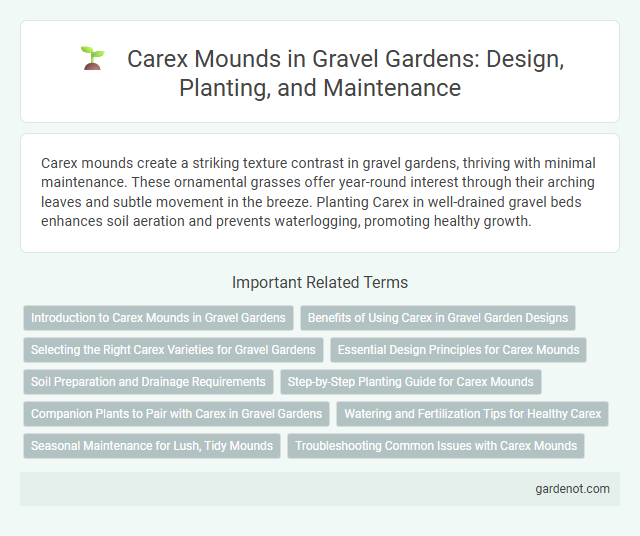Carex mounds create a striking texture contrast in gravel gardens, thriving with minimal maintenance. These ornamental grasses offer year-round interest through their arching leaves and subtle movement in the breeze. Planting Carex in well-drained gravel beds enhances soil aeration and prevents waterlogging, promoting healthy growth.
Introduction to Carex Mounds in Gravel Gardens
Carex mounds are a popular choice for gravel gardens due to their dense, tufted growth and adaptability to poor, well-drained soils. These ornamental grasses create architectural interest with their fine-textured foliage, providing year-round structure and groundcover that suppresses weeds. Their drought tolerance and low maintenance requirements make Carex mounds ideal for sustainable, low-water landscape designs.
Benefits of Using Carex in Gravel Garden Designs
Carex mounds enhance gravel garden designs by providing year-round texture and structure, thriving in well-drained environments typical of gravel beds. Their drought tolerance reduces watering needs, aligning with sustainable landscaping practices. The dense foliage of Carex helps suppress weeds while adding visual interest through varied leaf colors and forms.
Selecting the Right Carex Varieties for Gravel Gardens
Selecting the right Carex varieties for gravel gardens involves prioritizing species that are drought-tolerant and thrive in well-drained, sandy soils typical of gravel landscapes. Varieties such as Carex flagellifera and Carex flacca are ideal due to their low water requirements and ability to maintain vibrant foliage in harsh conditions. Choosing native or regionally adapted Carex species enhances sustainability and supports local ecosystems within gravel garden designs.
Essential Design Principles for Carex Mounds
Carex mounds thrive with well-drained, moist soil and partial to full shade exposure, mimicking their natural woodland habitats. Incorporating layering principles by planting taller species behind the mound enhances visual depth and supports microclimate stability. Regular maintenance such as pruning dead foliage and dividing the clumps every few years promotes healthy growth and prevents overcrowding.
Soil Preparation and Drainage Requirements
Carex mound thrives best in well-draining, moderately fertile soil enriched with organic matter to ensure consistent moisture levels without waterlogging. Preparing the soil by incorporating compost or aged manure improves texture and nutrient content, promoting healthy root development. Adequate drainage is crucial to prevent root rot, making gravelly or sandy soils ideal for optimal growth in a gravel garden setting.
Step-by-Step Planting Guide for Carex Mounds
Planting Carex mounds in a gravel garden requires selecting a well-drained site with partial to full sun exposure and preparing the soil with organic matter for improved moisture retention. Dig a hole twice the root ball size, place the Carex plant gently, and backfill with soil while firming to eliminate air pockets, ensuring even root establishment. Water thoroughly after planting and maintain regular watering during the first growing season to promote healthy growth and mound formation.
Companion Plants to Pair with Carex in Gravel Gardens
Carex mounds thrive when paired with drought-tolerant companion plants such as lavender, sedum, and ornamental grasses, which complement their fine texture and form contrast in gravel gardens. These plants not only enhance visual interest but also share similar soil and moisture requirements, ensuring low maintenance and sustainability. Incorporating evergreen shrubs like rosemary or dwarf conifers further adds year-round structure and color diversity.
Watering and Fertilization Tips for Healthy Carex
Carex mounds thrive in well-drained soil with consistent moisture, requiring regular watering to keep the soil evenly moist but not soggy. Fertilize using a balanced, slow-release fertilizer in early spring to promote vigorous growth, avoiding excess nitrogen which can lead to weak, floppy foliage. Mulching around the base helps retain moisture and suppress weeds, supporting healthy root development.
Seasonal Maintenance for Lush, Tidy Mounds
Seasonal maintenance for Carex mounds in gravel gardens involves regular trimming to remove dead or yellowing foliage, promoting fresh, vibrant growth throughout spring and summer. Dividing the mounds every 2-3 years in early spring prevents overcrowding and maintains plant health and density. Consistent watering during dry spells and light mulching help retain moisture and suppress weeds, ensuring lush, tidy Carex mounds year-round.
Troubleshooting Common Issues with Carex Mounds
Carex mounds in gravel gardens often face challenges such as root rot caused by poor drainage and fungal infections resulting from excessive moisture retention. Address water management by ensuring well-draining soil and avoid overwatering to mitigate these issues. Regularly inspect for pests like aphids or slugs, which can damage Carex foliage and stunt growth if left untreated.
Carex mound Infographic

 gardenot.com
gardenot.com